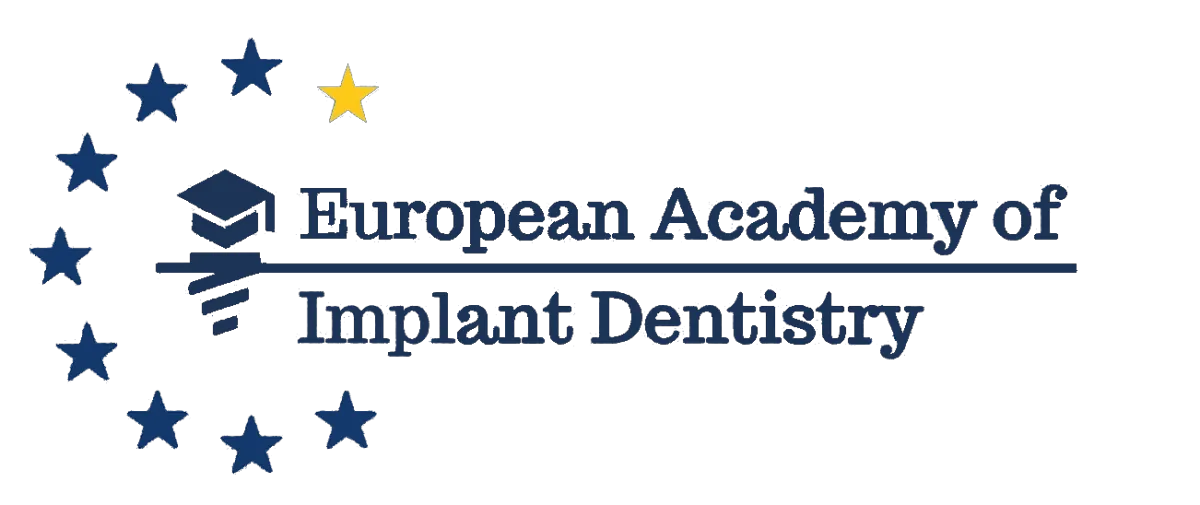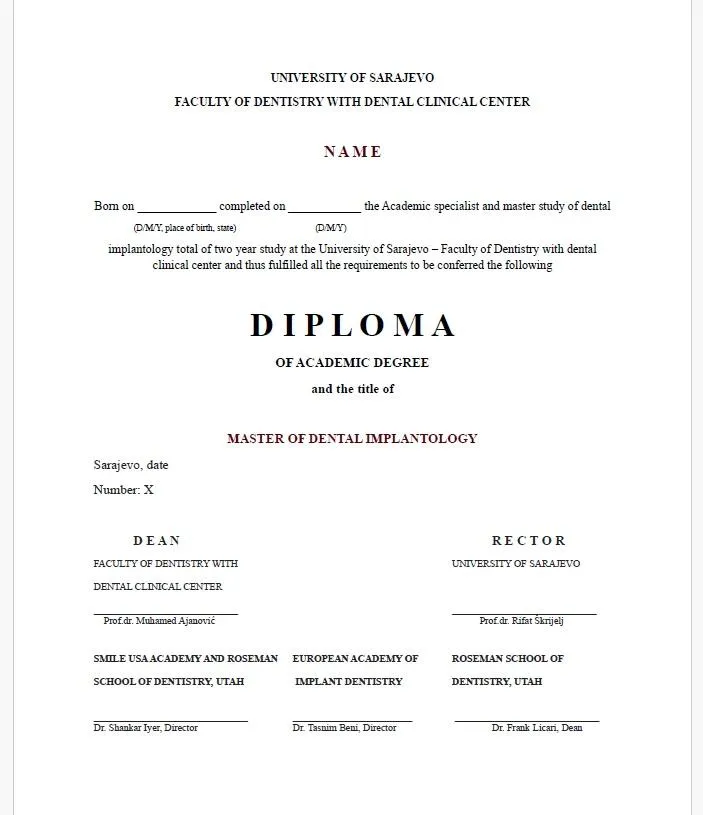


ACADEMIC DEGREE
MASTER OF DENTAL IMPLANTOLOGY
General Objectives
To impart the participants the understanding of the diagnostic and treatment modalities necessary to properly treat patients who are candidates for dental implant therapy. The interdisciplinary approach utilizing case based learning methodology will include lectures, demonstrations, interactive seminars, hands on sessions and relevant review of literature emphasizing evidence based clinical approach.
To provide an intensive overview of the state-of-the-art in implant dentistry.
Provide live surgical and prosthetic demonstrations on patients.
To aid the participants in the preparation for the implant privileges in the middle east and for the AAID Associate Fellow/Fellow membership examinations.
To help the participants develop clear solutions that fit the problems and its inherent conditions encountered in the pratice of implant dentistry, based upon information provided and clearly explicated reasoning.

Academic Specialist in Implant Dentistry
1. Diagnostic and Treatment Planning
● To help understand the diagnostic and treatment modalities necessary to properly treat patients requiring implant dentistry.
● To meet the patient before meeting the mouth (determining the patient’s needs, desires, motivations and goals).
● To provide an organized approach to examination, taking records, patient evaluation, obtain appropriate tests and radiographs and formulate a clinical decision making tree (vertical treatment planning).
● To recognize and incorporate an interdisciplinary approach to treatment planning.
● To demonstrate the clinical setting of inserting dental implants.
● To review sterilization and clean room protocols.
● To review radiographic and pre-surgical planning.
● To review implant insertion protocols.
● To provide an indepth live demonstration of the actual surgical sequencing and protocol for endosseous dental implants – root form/plate form.
● Review of literature about valid scientific evidence.
● To provide an overview of Evidence based dentistry.
● To help a reader to critically evaluate articles published in peer reviewed literature.
● Evaluate and verify if the results from one system can be extrapolated to another.
● Review of various surface modifications including – coatings, coined, acid-etched, small/large grit blasted, diffusion bonded microspheres and other interface enhancing technologies.
● Factors to consider in choosing the appropriate implant systems.
2. Anatomy and Bone Biology
● To illustrate applied anatomy of the maxillofacial region as it relates to implant dentistry.
● To review the basics of gross anatomy through dissection.
● To review regional anatomy with all the vital landmarks as it relates to diagnosis and surgical planning.
● To review correlation of radiographic images with antomical structures.
● To review an anatomic approach to local anesthesia of mandible and maxilla.
● To review anatomical spaces of the head and neck.
● To review anatomy of the maxillary sinus.
●To review fundamental pharmacological priciples of drug abosorption, half-lives, dosage and regimen of medications used in conjunction with dental implants.
● To provide a practical review of drug interactions, indications, contraindications and alternative medications of drugs taken by patients, drugs prescribed for implant surgeries and systemic and local enhancing factors.
● To elaborate on the risk factors associated with dental implants – patients on chemotherapy, smoking, systemic conditions that influence the outcome of the survival rates of dental implants.
● To review the basics of bone biology.
● To review adaptation, modeling and remodelling (RAP – concepts of Regional Acceleratory Phenomenon) etc.
● To understand the biological basis for bone healing, resorption, and related bone changes.
● To define and describe osseointegration, osseopreservation, fibro-osseous integration for bone support around dental implants.
● To review and describe micro-anatomy – light microscopic and ultra microcscopic levels.
● To review levels of bone injury resulting from osteotomy preparations, heat generation with various drills speeds, aspetic thermal necrosis, appositional and undermining resorptive patterns of osseous healing in osteotomies.
● To review evidence through animal models and correlation of sigma cycles of bone healing.
● To review the microscopic level the bone response to surface modifications and enhancements of the implant interface.
● To review principles of vertical treatment planning by creating a decision tree for implant modality selection, preferred choices etc.
● To help organize the data gathered from the initial interview to the wax up and creating the appropriate treatment plan that fulfills the patients needs and satisfies their wants.
● To review how to customize the treatment plan for every individual.
● To review instrument care and sterilization techniques.
3. Surgical Objectives
● To review sterility vs Clean aseptic environment.
● To review preoperative preparation – Surgical drapes and equipment.
● To review treatment room preparation.
● To review surgical field preparation.
● To review clinical attire.
● To review instrumentation check list.
● To review anesthetics and pain control.
● To review incision and flap designs.
● To review evaluation of the available bone and management of osteotomy sites.
● To review implant drilling sequence and protocols.
● To review performing surgery with prosthodontic considerations.
● To review tissue management and methods of achieving hemostasis.
● To review sutures and suturing techniques.
● To review impression materials and provisionalization of immediate function implants.
● To review mini transitional implants – techniques, indications and applications.
● To review basics of bone expansion, manipulation and augmentation.
4. Prosthetic Objectives
● To review evaluation of patient expectations and avoidance of removable prosthesis, prosthesis stability, prosthesis retention, functional requirements placed upon prosthesis.
● To review predicting esthetic outcomes and satisfying esthetic expectations, creating an improvement in self confidence and self esteem.
● To review therapeutic/surgical concerns – short term success, long term prognoses:
○ Prosthetic: Insufficient inter arch space, extreme jaw relationships etc
○ Surgical: Medical, anatomical etc
● To review prosthetic design considerations, evaluation of structures to be replaced by prosthesis, esthetics – lip support, dento-gingival esthetics, phonetics, design for hygiene, soft tissue, ridge laps and emergence profiles, opposing dentition, length of edentuous spans, AP spreads, cantilevers etc., parafunctional habits etc.
● To review control of biomechanical stress, reduction of forces of occlusion, narrowed occlusal table, minimal posterior cusp height, occlusal materials and design, occlusal schemes for implants, distribution of forces of occlusion, number and size of implants used, angulation of implants and offsets of prosthesis, reduction of cantilevers, prosthesis design considerations for screw retained and cemented restorations.
● To review prosthetic complications, mechanical problems, excessively inclined implants, difficulty in obtaining passivity of fit of prosthesis, failure of prosthetic components, broken abutment screws, migrating interlocks etc., loss of fixture integration.
● To review prosthesis design guidelines for different clinical situations:
○ I. Protocols for Single tooth
○ II. Protocols for quadrant restorations
○ III. Protocols for Removable prosthesis (Overdentures)
Learn More
● Home
● Program Overview
● Objectives & Curriculum
● Faculty
● Dates
● Locations / Venue
● Registration
● Program Tuition
● Gallery
● Contact us
Academic Specialist in Implant Dentistry
● Obtain an accredited degree in implant dentistry that demonstrates the highest level of training obtainable in an academic setting.
● To make our scholars competent in advanced implant procedures.
● Ability to place and restore advanced and complex reconstructive procedures that include graftless solutions, sinus lifts, block grafts and connective tissue grafts.
● To gain recognition as an implant specialist with a valid credential for academic appointments.
● In addition to the specialist training, candidates will be able to handle complications and manage failures with predictable approaches.
● To obtain competency in advanced dental implant procedures that is not normally taught in dental schools.
● To bring a scientific foundation for treatment planning at a level that is not influenced by skill or individual opinions.
● An evidence based approach to clinical procedures that will result in predictable outcomes.
● To teach sinus augmentation procedures in atrophic ridges for posterior maxillary rehabilitation.
● To be familiar with zygomatic implants and pterygoid implants for graftless solutions.
● Perform block grafting procedures.
● To be competent in placing all on x implant treatment for full arch restorations.
● To manage atrophic ridges through ridge expansions and guided bone regeneration.
● Perform full arch surgeries with immediate function
● Plan digital work-flow with stackable guides and provide immediate Provisionals.
● Recognize complications and implement procedures to handle complications and long term failures.
● Utilize lasers to manage peri implantitis.
All rights reserved ® 2024
European Academy Of Implant Dentistry
